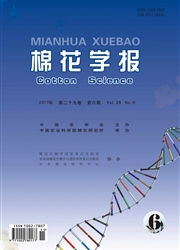

 中文摘要:
中文摘要:
【目的】研究不同磷效率棉花品种的根系形态和磷酸酶活性对不同供磷强度的响应。【方法】以前期筛选获得的磷高效品种新陆早19号和磷低效品种新陆早13号为材料,通过营养液培养比较不同供磷强度下各品种生物量、磷含量、根系形态和磷酸酶活性的变化。【结果】供磷强度达到50μmol·L~(-1)后,棉花生物量和根系长度不再随供磷强度增加而增加。棉花根表分泌磷酸酶活性随供磷强度增加而急剧下降,营养液实际p H下根系分泌的酸性磷酸酶活性与植株磷浓度显著负相关。根系形态对供磷强度的响应不敏感,仅在不供磷与供磷条件下存在显著差异。2个品种在磷效率方面的差异主要表现在磷的利用效率上,在供磷强度为0~250μmol·L~(-1)条件下,新陆早19号的磷利用效率显著高于新陆早13号。【结论】棉花根系形态特征参数和根系分泌质子与有机酸的数量对供磷强度的响应不敏感。不同磷利用效率品种的发现对于今后棉花节磷增效的生物学潜力与调控途径的研究提供了十分有效的实验材料。
 英文摘要:
英文摘要:
[Object] To understand the variation of the response of root morphology and phosphatase activity of two cotton vari- eties to five phosphorus supply levels. [Method] A high phosphorus efficient variety Xinluzao 19 and a low phosphorus efficient variety Xinluzao 13 were selected as testing plants, through comparing the changes of biomass, phosphorus content, root mor- phology and phosphatase activity at different phosphorus supply levels in nutrient solution culture. [Result] When phosphorus supply was higher than 50 μmol. L-1, the increase of phosphorus supply will not improve biomass and root length anymore. The activity of phosphatase on cotton root surface decreased sharply with the increase of phosphorus supply, the activity of acid phosphatase at actual pH was negatively correlated with plant phosphorus concentration. The response of root morphology to phosphorus supply was not sensitive, there was a significant difference only under the conditions between treatment of no phos- phorus and those of phosphorus supply. When phosphorus supply was 0-250 μmol. L-1, the P utilization efficiency of Xinluzao 19 was significantly higher than that of Xinluzao 13. [Conclusion] It can be considered that the response of cotton root morphol- ogy characteristic parameters and the quantity of the root release of protons and organic acids to phosphorus supply is not sensi- tive. This provided a very effective experimental material on saving phosphorus and increasing its efficiency of the biological po- tential and regulation pathway of cotton with phosphorus utilization efficiency genotypes discovered.
 同期刊论文项目
同期刊论文项目
 同项目期刊论文
同项目期刊论文
 期刊信息
期刊信息
